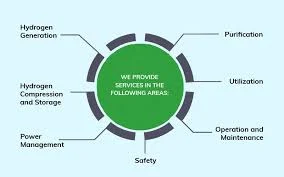As the global transition toward sustainable and clean energy gains momentum, two powerful concepts are emerging at the forefront of innovation: **Green Hydrogen** and **Energy-as-a-Service (EaaS)**. These solutions promise to reshape how we produce, store, distribute, and consume energy while addressing the dual challenges of climate change and energy security. In this in-depth, SEO-friendly article, we explore what green hydrogen and EaaS mean, how they work, their benefits, and how they are unlocking new opportunities across industries and communities.
What is Green Hydrogen?
"Green hydrogen" is hydrogen gas produced using renewable energy sources such as wind, solar, or hydropower. Unlike grey or blue hydrogen, which are derived from fossil fuels and involve carbon emissions, green hydrogen is entirely emissions-free, making it a key player in the decarbonization of hard-to-abate sectors.
Green hydrogen is produced through "electrolysis" a process that splits water (H2O) into hydrogen (H2) and oxygen (O2) using electricity from renewable sources. The result is a clean fuel that can be stored, transported, and used across a range of applications.
* Industrial processes (steel, cement, ammonia)
* Transportation (fuel cell vehicles, ships, and aircraft)
* Power generation and grid balancing
* Residential and commercial heating
What is Energy-as-a-Service (EaaS)?
Energy-as-a-Service (EaaS): is a business model that enables consumers—especially businesses and industrial users—to outsource their energy needs to a third party. Rather than owning and managing their own energy systems, customers pay for energy services such as heating, cooling, lighting, or electricity as a subscription.
* Energy Supply: Delivered through renewables, grids, or hybrid systems.
* Energy Storage: Battery systems for load management and peak shaving.
* Energy Management: Monitoring, analytics, and automation tools to optimize usage.
* Financing and Performance Contracts: No upfront capital; payment based on usage or performance.
EaaS models are ideal for organizations aiming to reduce carbon footprints, increase energy efficiency, and minimize capital expenditure.
The integration of "green hydrogen" into "Energy-as-a-Service" models is a game-changer. It allows companies and communities to access clean, reliable, and affordable energy without the complexity of managing infrastructure. For instance, industrial parks or logistics hubs can deploy green hydrogen systems operated by a service provider, paying only for the energy consumed.
Benefits of this Convergence:
* Zero-Emission Operations
* Predictable Energy Costs
* Decentralized and Resilient Energy Systems
* Increased Scalability and Flexibility
Why Green Hydrogen and EaaS Are the Future
1. Decarbonization of Industries
Heavy industries account for nearly 30% of global CO2 emissions. Green hydrogen offers a viable path to decarbonize these sectors, while EaaS ensures affordable and scalable implementation.
2. Energy Resilience and Independence
By producing and consuming hydrogen locally, communities and businesses reduce reliance on fossil fuels and centralized power grids.
3. Financial Accessibility
EaaS eliminates the need for heavy upfront investment, making clean energy accessible to SMEs, governments, and underserved areas.
4. Policy Alignment and Incentives
Many countries are offering grants, tax breaks, and subsidies for green hydrogen and EaaS models, encouraging faster adoption.
* Hydrogen-Powered Public Transport: Cities in Europe and Asia are deploying hydrogen buses and trains with EaaS providers managing the fueling stations and infrastructure.
* Green Industrial Parks: Facilities powered by on-site hydrogen plants, managed under EaaS contracts.
* Remote and Island Communities: Off-grid renewable energy coupled with hydrogen storage and distributed via EaaS.
* Data Centers and Commercial Buildings: Using green hydrogen fuel cells for backup power and energy management through EaaS providers.
Challenges and Considerations:
1. Infrastructure Development
Building electrolyzers, storage systems, and refueling stations requires significant investment and planning.
2. Regulatory and Safety Standards
Governments must establish clear guidelines for hydrogen safety, transport, and usage.
3. Technological Maturity
While promising, some hydrogen applications are still in the pilot phase and need further innovation.
4. Public Awareness and Acceptance
Adoption depends on educating businesses and consumers about the reliability and benefits of green hydrogen and EaaS.
Advanced technologies like AI, IoT, blockchain, and smart sensors are being used to optimize hydrogen production and EaaS delivery. Predictive analytics, real-time monitoring, and performance optimization help maximize efficiency and reduce costs.
Conclusion: A New Energy Era
The integration of "Green Hydrogen" and "Energy-as-a-Service" marks a pivotal shift in the global energy landscape. As the world races to meet net-zero goals, these innovations offer scalable, sustainable, and economically viable solutions for a carbon-neutral future.
Whether you're a policymaker, business owner, investor, or environmental advocate, embracing these models today means leading the change toward a cleaner and more resilient tomorrow. The energy transition is not just about changing fuels—it's about reimagining systems, services, and societies for the better.
If you're looking to implement green hydrogen or adopt an EaaS model for your business or community, now is the time to act. The future is green, and it's available as a service.









.jpeg)


0 Comments